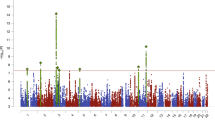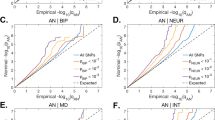Abstract
Anorexia nervosa (AN) is a common, severe and disabling psychiatric disorder, characterized by profound weight loss and body image disturbance.1 Family and twin studies indicate a significant genetic contribution2,3 and pharmacological data suggest possible dysfunction of the serotonergic4,5 and dopaminergic6–9pathways. Catechol-O-methyltransferase (COMT) is a candidate gene for mediating susceptibility to AN since it is involved in the dopamine catabolism10 and because its functional polymorphism (Val/Met 158) determines high (H) and low (L) enzymatic activity alleles.11 Fifty-one Israeli AN patients and their parents were genotyped with the COMT polymorphism. Using the haplotype relative risk (HRR) method it was found that the frequency of the H allele among alleles transmitted to AN patients from their parents was significantly higher than in those not transmitted (68% vs 51% χ2 = 5.20, df = 1, P = 0.023, odds ratio: 2.01). Transmission disequilibrium test (TDT) revealed that out of 49 heterozygote parents the H allele was transmitted to AN patients 33 times while the L allele was transmitted only 16 (McNemar's χ2 = 5.90, df = 1, P = 0.015). Our study suggests that the COMT gene is associated with genetic susceptibility to AN, and that individuals homozygous for the high activity allele (HH) have a two-fold increased risk for development of the disorder.
This is a preview of subscription content, access via your institution
Access options
Subscribe to this journal
Receive 12 print issues and online access
$259.00 per year
only $21.58 per issue
Buy this article
- Purchase on Springer Link
- Instant access to full article PDF
Prices may be subject to local taxes which are calculated during checkout
Similar content being viewed by others
References
Becker AE, Grinspoon SK, Klibanski A, Herzog DB . Eating disorders N Engl J Med 1999 340: 1092–1098
Strober M . Family-genetic studies of eating disorders J Clin Psychiatry 1991 52: (Suppl) 9–12
Gorwood P, Bouvard M, Mouren-Simeoni MC, Kipman A, Ades J . Genetics and anorexia nervosa: a review of candidate genes Psychiatr Genet 1998 8: 1–12
Brewerton TD, Jimerson DC . Studies of serotonin function in anorexia nervosa Psychiatry Res 1996 62: 31–42
Weizman R, Carmi M, Tyano S, Apter A, Rehavi M . High affinity [3H]imipramine binding and serotonin uptake to platelets of adolescent females suffering from anorexia nervosa Life Sci 1986 38: 1235–1242
Barry VC, Klawans HL . On the role of dopamine in the pathophysiology of anorexia nervosa J Neural Transm 1976 38: 107–122
Morley JE, Blundell JE . The neurobiological basis of eating disorders: some formulations Biol Psychiatry 1988 23: 53–78
Kaye WH, Ebert MH, Raleigh M, Lake R . Abnormalities in CNS monoamine metabolism in anorexia nervosa Arch Gen Psychiatry 1984 41: 350–355
Kaye WH, Frank GK, McConaha C . Altered dopamine activity after recovery from restricting-type anorexia nervosa Neuropsychopharmacology 1999 21: 503–506
Axelrod J, Tomchick R . Enzymatic O-methylation of epinephrine and other catechols J Biol Chem 1958 233: 702–705
Lachman HM, Papolos DF, Saito T, Yu YM, Szumlanski CL, Weinshilboum RM . Human catechol-O-methyltransferase pharmacogenetics: description of a functional polymorphism and its potential application to neuropsychiatric disorders Pharmacogenetics 1996 6: 243–250
Terwilliger JD, Ott J . A haplotype-based ‘haplotype relative risk’ approach to detecting allelic associations Hum Hered 1992 42: 337–346
Spielman RS, McGinnis RE, Ewens WJ . Transmission test for linkage disequilibrium: the insulin gene region and insulin-dependent diabetes mellitus (IDDM) Am J Hum Genet 1993 52: 506–516
Frisch A, Postilnick D, Rockah R, Michaelovsky E, Postilnick S, Birman E et al. Association of unipolar major depressive disorder with genes of the serotonergic and dopaminergic pathways Mol Psychiatry 1999 4: 389–392
Eisenberg J, Mei-Tal G, Steinberg A, Tartakovsky E, Zohar A, Gritsenko I et al. Haplotype relative risk study of catechol-O-methyltransferase (COMT) and attention deficit hyperactivity disorder (ADHD): association of the high-enzyme activity Val allele with ADHD impulsive-hyperactive phenotype Am J Med Genet 1999 88: 497–502
Vandenbergh DJ, Rodriguez LA, Miller IT, Uhl GR, Lachman HM . High-activity catechol-O-methyltransferase allele is more prevalent in polysubstance abusers Am J Med Genet 1997 74: 439–442
Lavigne JA, Helzlsouer KJ, Huang HY, Strickland PT, Bell DA, Selmin O et al. An association between the allele coding for a low activity variant of catechol-O-methyltransferase and the risk for breast cancer Cancer Res 1997 57: 5493–5497
Li T, Ball D, Zhao J, Murray RM, Liu X, Sham PC et al. Family-based linkage disequilibrium mapping using SNP marker haplotypes: application to potential locus for schizophrenia at chromosome 22q11 Mol Psychiatry 2000 5: 77–84
Karayiorgou M, Sobin C, Blundell ML, Galke BL, Malinova L, Goldberg P et al. Family-based association studies support a sexually dimorphic effect of COMT and MAOA on genetic susceptibility to obsessive-compulsive disorder Biol Psychiatry 1999 45: 1178–1189
Mynett-Johnson LA, Murphy VE, Claffey E, Shields DC, McKeon P . Preliminary evidence of an association between bipolar disorder in females and the catechol-O-methyltransferase gene Psychiatr Genet 1998 8: 221–225
Gershon ES, Schreiber JL, Hamovit JR, Dibble ED, Kaye W, Nurnberger JI Jr et al. Clinical findings in patients with anorexia nervosa and affective illness in their relatives Am J Psychiatry 1984 141: 1419–1422
Daniels JK, Williams NM, Williams J, Jones LA, Cardno AG, Murphy KC et al. No evidence for allelic association between schizophrenia and a polymorphism determining high or low catechol-O-methyltransferase activity Am J Psychiatry 1996 153: 268–270
Acknowledgements
This study was supported by grants (42-97) from the National Institute for Psychobiology in Israel and (610-212.02) from the German–Israeli Foundation for scientific research and development (GIF).
Author information
Authors and Affiliations
Corresponding author
Rights and permissions
About this article
Cite this article
Frisch, A., Laufer, N., Danziger, Y. et al. Association of anorexia nervosa with the high activity allele of the COMT gene: a family-based study in Israeli patients. Mol Psychiatry 6, 243–245 (2001). https://doi.org/10.1038/sj.mp.4000830
Received:
Revised:
Accepted:
Published:
Issue Date:
DOI: https://doi.org/10.1038/sj.mp.4000830
Keywords
This article is cited by
-
The impact of COMT, BDNF and 5-HTT brain-genes on the development of anorexia nervosa: a systematic review
Eating and Weight Disorders - Studies on Anorexia, Bulimia and Obesity (2021)
-
A common polymorphism of COMT was associated with symptomatic lumbar disc herniation based on a large sample with Chinese Han ancestry
Scientific Reports (2018)
-
Catechol-O-methyltransferase activity in erythrocytes from patients with eating disorders
Eating and Weight Disorders - Studies on Anorexia, Bulimia and Obesity (2016)
-
Association between a common CYP17A1 haplotype and anxiety in female anorexia nervosa
Archives of Women's Mental Health (2013)
-
A debate on current eating disorder diagnoses in light of neurobiological findings: is it time for a spectrum model?
BMC Psychiatry (2012)



